Social Perspective
• Christianity- a widespread faith
• Economic activities – Hunting, fishing, forestry.
• Subsistence agriculture supplemented by hunting, Crops – Mustard (Sarson),Chillies
• Stilted thatched huts, rattan walls, within bamboo fenced compounds
• Sometimes timbered, two-storied structures house several families, corrugated tin roofing also used
• Corn/maize is a major dietary supplement, pineapples, oranges also locally grown
• Pied Hornbill Casks to adorn houses, a bird driven to near-extinction by over-hunting
Environmental perspective
• Northern-most Rainforests in the world
• High Biodiversity – Biodiversity Hotspot
06/12/2010
The Rajdhani Express wended its way towards Dibrugarh, the starting point for what was to be an unusually stimulating and mind-opening trip into the seldom travelled villages of Arunachal Pradesh. A cold morning, and my two companions Rajeev and Alpheus Moses greeted me at the market place, and we made our way to complete permit formalities at the Arunachal Bhavan in Mohanbari. It was late afternoon by the time we got the necessary sorted and we could finally let our enthusiasm loose and head towards Miao, our overnight destination. En route, dinner and a Baskin Robbins treat at Tinsukia, did much to buoy our spirits, and get us into the mood for what lay ahead.
07-08/12/2010
With some more permits for Vijoynagar, purchase of essential groceries to tide us through the trek, and a hired van, we were on the move again. . Mpen is the entry check point for the Namdapha Forest and leads to Deban. The Forest Guest House at Deban (20th mile) provides accommodation to the weary. At Bodhisatta, a nearby village, with a name still resounding with the religious influence of Buddhism, four porters (Lal Babu, Manudhan, Ronjan and Anchidan) and Ashang Mosang Sir, a representative of the Forest Department, joined our motley crew. This village is inhabited by the Chakma tribe, descendants of the Bangladeshi refugees. Vijaynagar, a 7 day trek would be a grueling one but knowing that we had good local guides to take us through was reassuring.
09/12/2010
The overcast sky held the key to the terrain that lay before us. A slight drizzle, did nothing to dampen our spirits, as we trudged through the slush and leeches, over the ups-and-downs and took an offshoot from M.V Road. At dusk, we reached the 27th Mile, our proposed destination. Yet, it seemed the day’s toils were not yet over, the more agile porters had raced ahead with our supplies and tents. Darkness set in within half an hour, and a concerned flashlight urged us forward through more slush. Several slips and falls later, we halted at the 32nd Mile, our riverside abode for the night.
10/12/2010
From the 32nd Mile, we walked towards the Burma Nala. The route was interspersed with bamboo foot bridges that forded the gushing river beneath, known as Dallongs in the local language. Sturdy structures used for crossing rivers and as fishing outposts, Dallongs are washed away with every monsoon only to be rebuilt again when the river water calms down. This toil on the part of the villagers costs each pedestrian Rs 5 to make the journey to the other bank. This is just one of many examples of the sustainable lifestyles these communities lead. The halt was again on the riverside. A Lisu delicacy, of barbequed bugs on skewers, called Gandhipoo (I had a good laugh over that name), was sadly beyond my vegetarian palate. The bonfires that spelt doom for the bugs lent light and cheer to a weary night.
11/12/2010
We had been traipsing through Lisu villages yet it was not a surprise to see the morning start off with a display of the fishing prowess of the Lisu men. The river had yielded enormous catfish, one of which was sold to provide breakfast for the group. As a vegetarian, I had to seek sustenance in a more humble fare – rice and potato.
The Lisu, are also expert hunters, whose diet is mainly bushmeat and gamefowl, supplemented by their subsistence agricultural yields. The Lisu originally migrated from Myanmar and was ‘discovered’ in 1961 by Major General A.S. Guraya of the Assam Rifles during his Chaukan pass expedition, leading to the settlement of 192 families of Nepali ex-servicemen in the valley in 1965. [Maj. General A.S Guraya has named Vijoynagar and Pritinagar, after his son, Vijay and his daughter Priti, respectively] This is the main community both affecting and dependent upon the Namdapha National Park. The conservation of this haven is dependent on the interaction between the age-old traditions and the newer principles, the environmental awareness disseminated within these communities and work that tries to collaborate the Lisu knowledge about the forest while planning effective management strategies.
Crossing the Burma Nala meant wading through knee-deep ice cold water, an effective antidote to a heavy breakfast. Dihing River flowed alongside us, as we trekked onto the village at 52nd Mile. A warm host, pop corn and tea, eased our woes. A proper house was a welcome relief after the tiring journey and the aches garnered during the previous two nights over rocky terrain.
While sipping warm tea, Christmas carols blaring over a loudspeaker, drew our attention towards the Lisu Church. The festivities of yuletide were just around the corner. A strange juxtaposition of faiths defines this area, and Christianity is the last piece of the jigsaw. Yet the faith is mostly pagan in its principles, culture too has not tuned itself to Christian overtures, but Christmas is celebrated with much fervour.
At this point we added another porter to our ensemble, a local forest boy, Jalim, who could speak Hindi as well as Lisu, bridging the lingual barrier between the locals and ourselves.
12/12/2010
Rain showers delayed our day’s trek to the 55th Mile. More slush made our clothes a launderer’s nightmare. Four hours later, we sought refuge at a humble shelter, whose only claim over that status was a roof to shield the rain. It seems some leeches had piggybacked onto the unsuspecting wayfarers and disrupted our night’s rest with their sadistic bloodsucking. Peace was ill-begotten, as we rid ourselves of the leeches and our weariness. The longest day walk since we had set out lay ahead of us.
13/12/2010
65th Mile was a five hour walk, through yet more slush, leeches and colourful language. At two in the afternoon we camped at another ramshackle open sided-hut. A welcome, albeit freezing plunge into the water washed off the grit from our bodies and our clothes. Wish the leeches could be dissuaded as easily. An early dinner, and we fell prey to the lures of the Sandman.
14/12/2010
77th Mile was another milestone on our slushy route towards Vijoynagar. The village on the banks of the Dihing River was a scene of tranquility; kids playing on the banks eager to welcome the alien-looking tourists and bamboo huts, a cheery respite from the abodes of the past few nights. A rustic farm life, replete with pigsties and barns was offset by a 10-odd seater theatre, with solar-powered backup. Sadly, we were unable to catch any show that night.
15/12/2010
It was a good thing we could keep track of the dates, as I would not have liked to miss out on my birthday. The day dawned, and our route lead us to Gandhigram, the biggest Lisu settlement in that area. We had planned to stay at the Intelligence Bureau, a guest house located upon a hill that overlooked the village. The caretaker welcomed us to his place. Lisu tea, pop corn and guavas were interesting accompaniments to the conversation.
What lifted my spirits the most was the prospect of the V-Sat phone in Gandhigram, which would connect me to my folks, and help me reacquaint myself with the life I had left behind for a short while. A quick shower later, I made my way to the lonesome STD booth to queue up with the other people who wanted to make calls to their relatives in Miao. It was a sliver of familiarity talking to family and friends, even if I had chosen to spend my 28th Milestone, exploring more historic ones.
What a great way to celebrate a birthday, in unknown lands and freezing climes but that is the dream of this footloose gypsy.
16/12/2010
Gandhigram to Vijoynagar is a four and a half hour walk on the MV Road. En route, Nepali villages like Ramnagar and Phapadbari make for interesting halts. Ramnagar is two and a half hours from Gandhigram and an hour from Phapadbari. We were most fortunate on this stretch of the route, as Phapadbari was playing host to its annual No-Moon day (Amavasya) Meena Bazaar; an eclectic forum for the sale of groceries, local food items, with some gambling and games thrown in. It was a raucous, cheery place, where all sorts of wares and hawkers vied for attention. It was apparent that such an event would encourage other village-folk to join as well. It was perhaps the best slice of this forgotten part of Arunachal Pradesh that we could partake.
Phapadbari is 45 minutes shy of Vijoynagar, and the IAF ALG (Indian Air Force Advanced Landing Ground). The runway, managed by the PWD for AN32 sorties to land at Vijoynagar, was under maintenance.
So eager was I to freeload onto the army helicopter that I decided to cool my heels at Vijoynagar till the next sortie. Little did I know that the wait would involve a 12 day stay and negotiations between the Army Commanding Officer and the Alpha Company’s Subedar, B.B.Rai. Not alien to pulling strings, I was finally able to hitch a ride back on the helicopter with a sick villager, rattan baskets and army jawans, as co-passengers.
The trip’s grand finale was an aerial view of all the places we had traipsed across, a fitting end to the adventure. Cloud-hazed summits, fleeting glimpses of icecaps in the distance, carpeted green forest valleys, the Dihing’s meandering braids. It seemed that a lot of nature had gone unobserved, while we had been discovering the cultural realms below. We seemed to have followed in the footsteps of not more than 3 – 4 groups, into these forsaken lands.


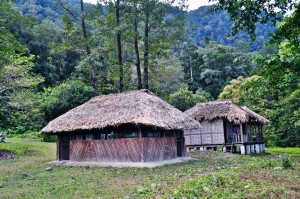
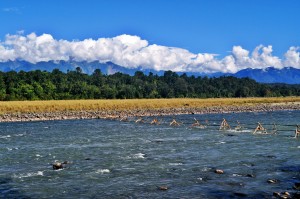
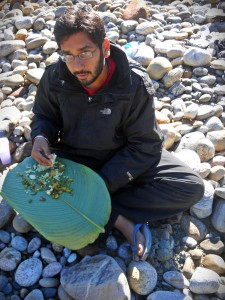


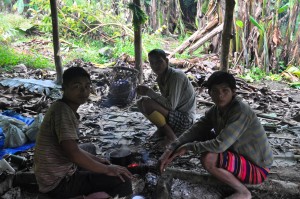
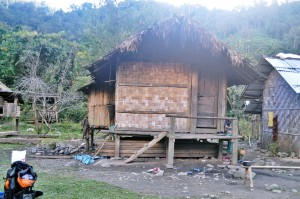
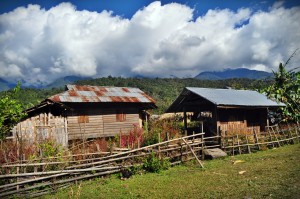
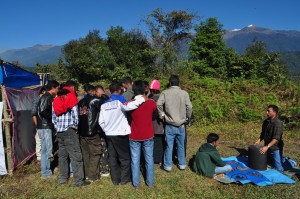

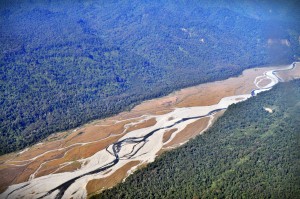
Amazing read! So eager to do the trek to Vijaynagar. How do I arrange all of this?